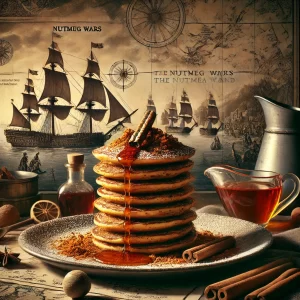The story of New York, one of the world’s most iconic cities, is intertwined with the complex and often brutal history of the spice trade. At the heart of this tale is a tiny, fragrant seed: nutmeg.
Once worth more than its weight in gold, nutmeg played a pivotal role in the power struggles between the Dutch and the British, two of the most formidable colonial powers of the 17th century.
This is the story of how the quest for control over this precious spice led to the exchange of a small but significant island, setting the stage for the birth of New York City.
Nutmeg: A Spice Worth Fighting For
In the 1600s, nutmeg was one of the most sought-after spices in the world. Native to the Banda Islands in present-day Indonesia, nutmeg was prized not only for its flavor but also for its supposed medicinal properties.
The spice was believed to cure everything from the common cold to the plague, making it a valuable commodity in Europe.
The Dutch East India Company (VOC), one of the most powerful trading companies in history, sought to monopolize the nutmeg trade. The VOC’s aggressive tactics, which included brutal suppression of the local population in the Banda Islands, allowed them to control the majority of the world’s nutmeg supply.
This dominance was a key part of the Dutch strategy to maintain their economic and colonial power.
The Conflict with the British
The British, however, were not content to let the Dutch control the lucrative spice trade unchallenged. In 1664, tensions between the two powers came to a head when the British seized New Amsterdam, a Dutch settlement located at the southern tip of Manhattan Island.
This strategic location was a vital part of the Dutch colonial empire, serving as a major trading post in North America.
In response, the Dutch launched several attempts to retake New Amsterdam but were ultimately unsuccessful. The ongoing conflict, combined with the high costs of maintaining overseas territories, led both sides to seek a resolution.
The Treaty of Breda: A Trade-Off for Nutmeg
In 1667, the Treaty of Breda was signed, bringing an end to the Second Anglo-Dutch War. The treaty is perhaps most famous for one of its territorial exchanges: the Dutch agreed to cede control of New Amsterdam (which the British promptly renamed New York) in exchange for the tiny island of Run, one of the Banda Islands and a key source of nutmeg.
At the time, this exchange seemed like a fair trade to the Dutch, who valued the continuation of their nutmeg monopoly over a distant colonial outpost.
However, history would prove this to be a monumental decision. While the Dutch continued to profit from the spice trade for a time, the long-term significance of New York as a global center of trade, finance, and culture would far outweigh the temporary riches of the nutmeg islands.
Nutmeg-Cinnamon Pancake Recipe
As we reflect on the history of nutmeg and its impact on global politics, why not enjoy the spice in a more peaceful and delicious way? These nutmeg-cinnamon pancakes are a delightful breakfast treat, combining the warm, aromatic flavors of two of the world’s most beloved spices.

Nutmeg-Cinnamon Pancakes
Ingredients
- 1 1/2 cups all-purpose flour
- 2 tablespoons sugar
- 2 teaspoons baking powder
- 1/2 teaspoon salt
- 1/2 teaspoon ground nutmeg
- 1/2 teaspoon ground cinnamon
- 1 cup milk
- 2 large eggs
- 2 tablespoons melted butter
- 1 teaspoon vanilla extract
- Additional butter for cooking
Instructions
- In a large mixing bowl, whisk together the flour, sugar, baking powder, salt, nutmeg, and cinnamon.
- In a separate bowl, whisk together the milk, eggs, melted butter, and vanilla extract.
- Pour the wet ingredients into the dry ingredients and stir until just combined. The batter should be slightly lumpy.
- Heat a non-stick skillet or griddle over medium heat and lightly grease with butter.
- Pour 1/4 cup of batter onto the skillet for each pancake. Cook until bubbles form on the surface and the edges look set, about 2-3 minutes. Flip and cook for another 1-2 minutes, or until golden brown.
- Repeat with the remaining batter, greasing the skillet as needed.
- Serve the pancakes warm with butter, maple syrup, or a sprinkle of additional cinnamon and nutmeg.